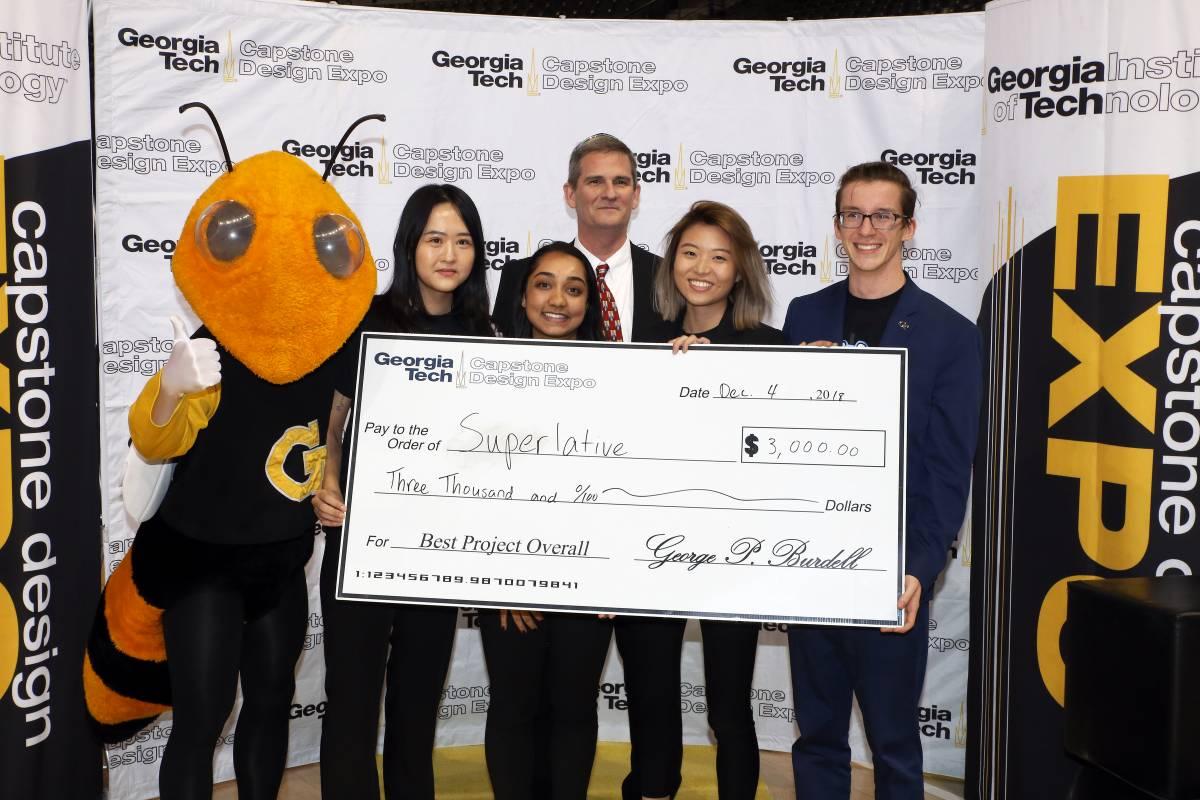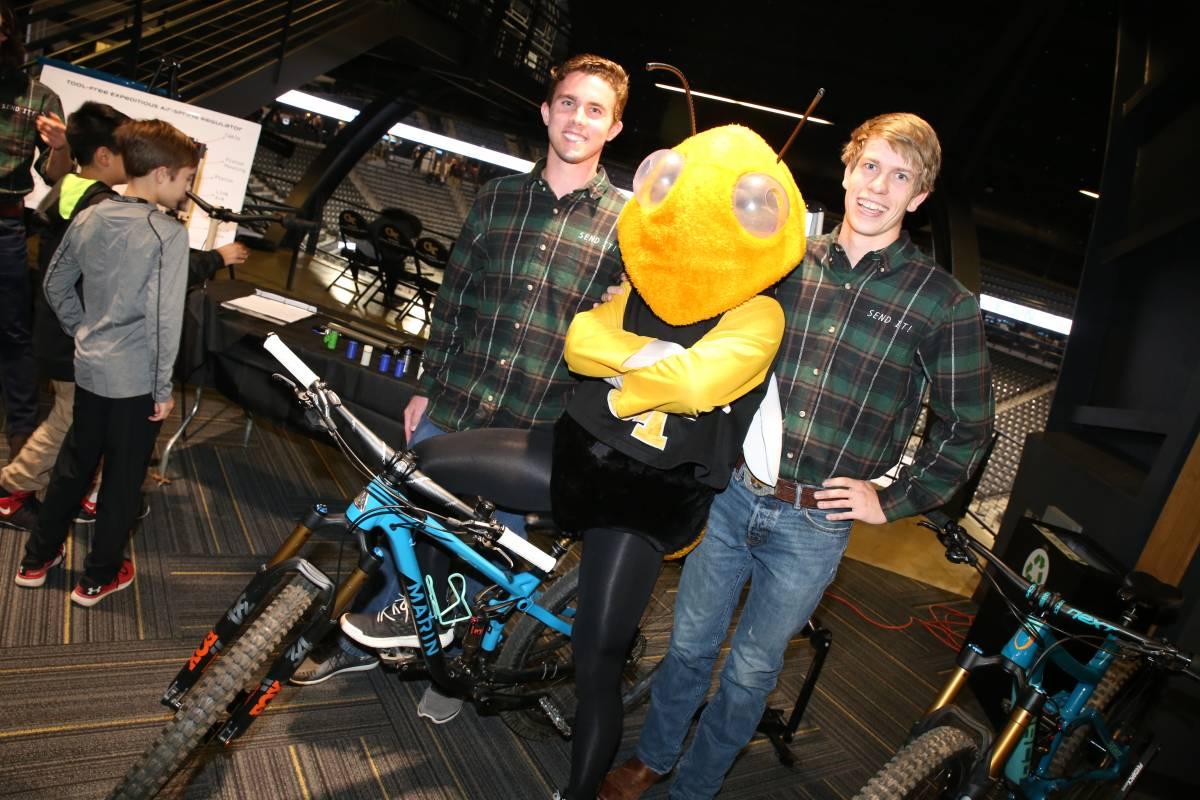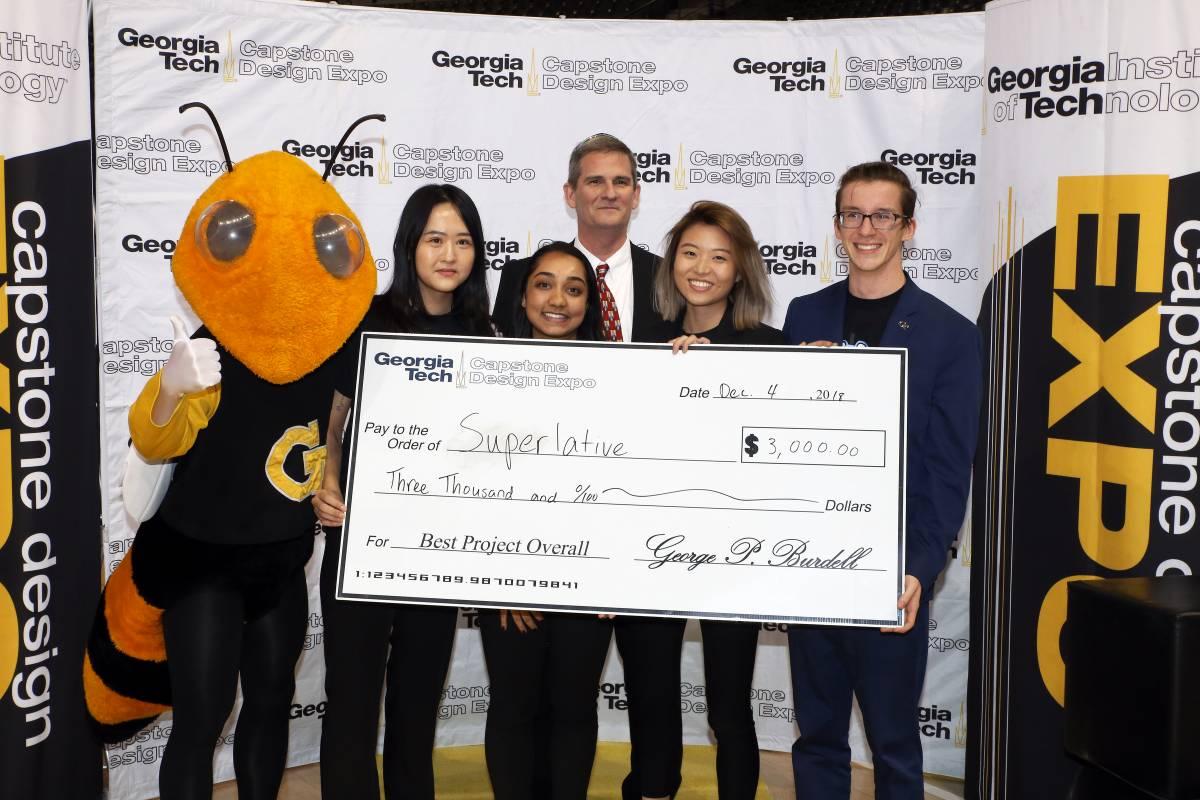Medical technology key focus for Capstone this year


As doctors get better at treating diseases, engineers continue to discover new solutions to medical issues that were previously thought to be impossible to solve. College of Engineering seniors were no different at this year’s Capstone Design Expo, with many of the teams concentrating their efforts on preventing, diagnosing, and treating diseases and health concerns.
Teams from nearly every school found ways to improve the well-being of people all over the world. Students from the School of Electrical and Computer Engineering created a device that detects instances of opioid overdose. A team from the Woodruff School of Mechanical Engineering designed and constructed a prototype that scans the skin of a patient’s arm to diagnose lymphedema. Interdisciplinary groups did everything from creating a system that provides a modern approach to quitting nicotine, to heating orthopedic implants.
At the Capstone Design Expo, 153 teams of graduating students got the chance to display prototypes of their ideas, which are representative of their years of engineering and design learning done while at Georgia Tech. They were judged by more than 150 experts and professionals from around the world, who scored each project and named a winner in each category.
This year’s winner was Supleurative, a biomedical engineering team that created a device that makes lung draining procedures possible and efficient in hospitals.
“I’m just blown away in terms of the recognition we’re getting for this,” said James Wroe, a member of Supleurative. “It’s really important to me that we’re doing work that’s translatable into the real world. I think that’s a big factor in why we won, is that it’s been recognized how useful this is going to be for people in the next year.”
The team’s members hope to test their product in a small clinical trial in Ethiopia this summer.

Fall 2018 Capstone Design Expo Winners
Overall winner: Supleurative
An efficient, reusable, and low-cost lung drain device that is fit for use in developing nations and can replace the current gravity drainage used at Ethiopian hospitals.
- James Wroe, Atlanta, Georgia
- Yige Huang, China
- Hannah Choi, Atlanta, Georgia
- Tara Ramachandran, Scarsdale, New York
Aerospace Engineering: The Squirrel Works
An unmanned long-range strike aerial vehicle to serve as a replacement for the F-111, F-117, and as a supplement to the B-2. Characteristics of the aircraft include low-observability, ability to access Anti-Access Area Denial airspace, radical maneuver capabilities, as well as being lighter, smaller, and less expensive than current piloted aircraft.
- Emily Paxton, Bangkok, Thailand
- Jared Mehnert, Lebanon, Ohio
- Wesley Gillman, Rogers, Arkansas
- Kyle Neville, Lawrenceville, Georgia
- Fahraan Badruddin, Duluth, Georgia
- Erica Hulette, Acworth, Georgia
Biomedical Engineering: aMAYOnnaising
A device that aids in reconnecting the bladder to the urethra after a prostatectomy.
- Nicholas Quan, Richmond Hill, Georgia
- Bailey Klee, Alpharetta, Georgia
- Madeline Smerchansky, Arlington, Virginia
- Rachel Mann, Homer Glen, Illinois
Civil and Environmental Engineering: BAMM Engineering
A project to widen a section of I-20 in Carroll County was temporarily shut down due to the negative safety impacts of the construction staging and traffic re-routing methods.
- Michael Nieman, Woodstock, Georgia
- Andrew White, Decatur, Georgia
- Matthew Gruba, Augusta, Georgia
- Bailey Little, Flowery Branch, Georgia
Electrical and Computer Engineering: PulseScan
An electrocardiogram (ECG) wearable that will track a user’s ECG signals and monitor them from one’s phone or laptop, warning of short-term and long-term heart risk while also providing information on physical fitness.
- Joseph Lennon, Fayetteville, Georgia
- Derin Ozturk, California
- Justin Cheung, Duluth, Georgia
- Sehej Ahluwalia, Plano, Texas
- Victor Barr, Berkeley Lake, Georgia
Industrial Design and Mechanical Engineering: Chopa
Design a collection of toys that use insights about compensating behaviors of accessibility-limited children to create a more comprehensive, well-rounded experience for all children.
- Jae Hyuk Kim, Industrial Design, Seoul, Korea
- Max Cohen, Industrial Design, Miami, Florida
- Elliot Manassa , Mechanical Engineering, Riverwoods, Illinois
- Matias Girardi, Mechanical Engineering, Buenos Aires, Argentina
- Kristin Andreassen, Industrial Design, Atlanta
Industrial and Systems Engineering: Cox Automotive
Our team is evaluating Cox Automotive's current process and providing recommendations on controllable decisions, such as vehicle relocating, reconditioning, and holding to reduce loss per vehicle.
- Margaret Jennings, Kennesaw, Georgia
- Will Olsson, Åhus, Sweden
- Meghan Rathie, Johns Creek, Georgia
- Siddhartha Meka, Snellville, Georgia
- Alan Johnson, Marietta, Georgia
- Ashley Paek, Johns Creek, Georgia
- Kelly Kronenberger, Suwanee, Georgia
- Sarah Stein, Carmel, Indiana
Mechanical Engineering (tie): W(hole) lotta trouble
Analyzing the shape and dimension of laser drilled holes in suture needles for quality control.
- Mónica López, Dorado, Puerto Rico
- Justin Tai, San Jose, California
- Yujung Ryu, Suwanee, Georgia
- Adam Garlow, Decatur, Georgia
- Zhigen Zhao, Hangzhou, China
Mechanical Engineering (tie): Send It!
TEAR is a system that controls the air spring characteristics in high performance mountain bike suspension forks.
- Nicholas Henderson, Flowery Branch, Georgia
- Admir Berisha, Bronx, New York
- Matei Dan, Atlanta, Georgia
- Hunter Brown, Bullard, Texas
Interdisciplinary: PPEeps
This project aims to increase workplace safety by decreasing the number of failures in the PPE required in Central Sterile Processing Units.
- Jordan Lo Coco, Mechanical Engineering, Pasadena
- Jim Peterson, Mechanical Engineering, Atlanta, Georgia
- Maylyn Parsons, Biomedical Engineering, Greenville, South Carolina
- Kendra Simpson, Biomedical Engineering, Cumming, Georgia